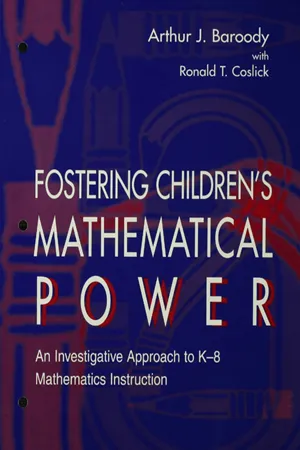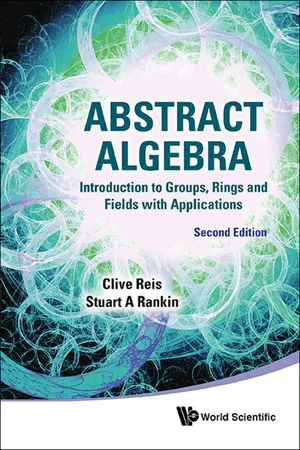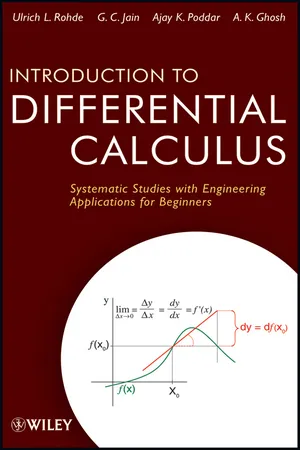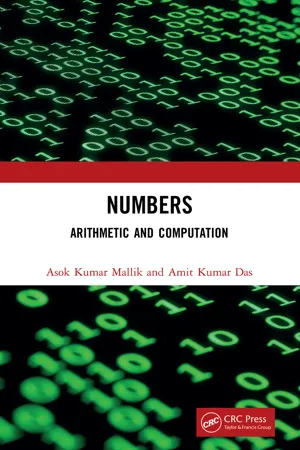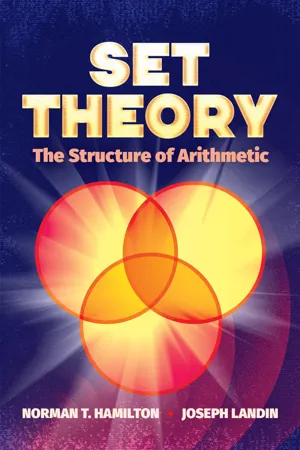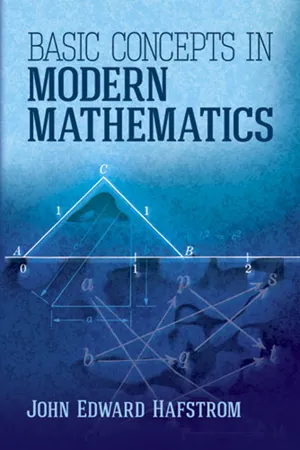Mathematics
Integers
Integers are whole numbers that can be positive, negative, or zero. They do not include fractions or decimals. In mathematics, integers are used to represent quantities such as counts or positions in a sequence. They are essential in various mathematical operations and are a fundamental concept in number theory and algebra.
Written by Perlego with AI-assistance
Related key terms
Related key terms
1 of 4
Related key terms
1 of 3
8 Key excerpts on "Integers"
- eBook - ePub
Fostering Children's Mathematical Power
An Investigative Approach To K-8 Mathematics Instruction
- Arthur Baroody, Arthur J. Baroody, Jesse L.M. Wilkins, Ronald T. Coslick(Authors)
- 1998(Publication Date)
- Routledge(Publisher)
Figure 8.5 ) and how to help children understand this type of number (Subunit 8•2•1). We then examine integer arithmetic (Subunit 8•2•2).8•2•1 The Concept of Integers Mathematics: Understanding IntegersFigure 8.5: A Need for Negative NumbersIntegers, why another set of numbers?The Role of the Integers. Sometimes it does not make sense to talk about numbers less than zero. For example, the attendance of class cannot drop below zero, even if a community is gripped by a plague or some other disaster. In such cases, the whole numbers do just fine, thank you. Sometimes it does make sense to talk about numbers less than zero. For example, it is cold out when the temperature drops below 0°C; it is very cold out when the temperature drops below 0°F. In the era of plastic credit, it is easier than ever to end up in debt. Bad football teams can end up with negative net yards gained. Some games, such as the television game show Jeopardy, entail penalty points and negative scores. In other games, such as the card game Hearts, a player is glad to run up a negative score, because the fewer points the better. In discussing elevation, one can go below as well as above sea level.Put differently, sometimes it is enough to know the size of a quantity; other times it is important to know a quantity’s size and its location. Whole numbers are fine for indicating a magnitude, but Integers are needed to indicate both magnitude and direction. With Integers, 0 is a reference point, and the (continued on page 8-23) sign of a number serves to indicate the number’s direction relative to 0. In brief, Integers are useful tools for situations when we need to know how big something is and where the bigness is.3Definition and Symbolism. Concretely, the minus sign in front of a number, such as −2, “turns [it] upside down, like the reflection of trees … on a river” (Sawyer, 1971, p. 62). Mathematically, negative numbers are defined as the opposites of positive numbers. For example, −2 is defined as the solution to the expression 2 + □ =0. For example, +2 and −2 indicate the same magnitude but −2 goes in the opposite direction of +2. A number line provides a clear depiction of this interpretation. For example, +2 can be thought of as two units to the right of zero; −2, as two units to the left - eBook - ePub
Abstract Algebra
Introduction to Groups, Rings and Fields with Applications
- Clive Reis, Stuart A Rankin;;;(Authors)
- 2016(Publication Date)
- WSPC(Publisher)
Chapter 4
The Integers
4.1 Introduction
The set of Integers consists of all the whole numbers, positive, negative and zero. As indicated earlier, this set will be denoted by . The subset + = { n ∈ | n ≥ 1 } is called the set of positive Integers, and the subset = { n ∈ | n ≥ 0 } is called the set of natural numbers, or the set of nonnegative Integers.In this chapter, we establish some basic properties of the Integers. We assume as an axiom (called the Well Ordering Principle) that every nonempty set of positive Integers contains a least integer and show how this gives rise to the principle of mathematical induction, a powerful tool we shall often use in this and subsequent chapters.After developing properties of divisibility, we prove the Fundamental Theorem of Arithmetic which states that every integer greater than 1 is uniquely expressible as a product of primes and deduce that there are infinitely many primes. We end the chapter with a discussion of linear congruences and show how they can be viewed as equations in certain algebraic systems. It is hoped that a familiarization with these concrete algebraic systems will help the reader make the transition to the more abstract structures to be studied in subsequent chapters.4.2 Elementary Properties
There are two familiar operations defined on ; namely, addition and multiplication. We shall assume that the reader is familiar with the following properties which we adopt as axioms.4.2.1 Axioms for the Integers.
(i)For all m, n, k ∈ , m + (n + k) = (m + n) + k; that is, addition is associative.(ii)0 has the property that for all m ∈ , 0 + m = m + 0 = m; that is, addition has 0 as identity element.(iii)For each m ∈ , there exists a unique n ∈ such that m + n = n + m = 0; that is, each element of - eBook - ePub
Introduction to Differential Calculus
Systematic Studies with Engineering Applications for Beginners
- Ulrich L. Rohde, G. C. Jain, Ajay K. Poddar, A. K. Ghosh(Authors)
- 2012(Publication Date)
- Wiley(Publisher)
Chapter 1 From Arithmetic to Algebra 1.1 IntroductionNumbers are symbols used for counting and measuring. Hindu–Arabic numerals 0, 1, 2, 3, . . . . . ., 9 are grouped systematically in units, tens, hundreds, and so on, to solve problems containing numerical information. This is the subject of Arithmetic . It also involves an understanding of the structure of the number system and the facility to change numbers from one form to another; for example, the changing of fractions to decimals and vice versa. A detailed discussion about the Real Number System is given in Chapter 3. However, it would be instructive to recall some important subsets of real numbers , known to us.Numbers, which are used in counting, are called natural numbers or positive Integers . The set of natural numbers is denoted by1.2 The Set of Whole NumbersThe set of natural numbers along with the number “0” makes the set of whole numbers, denoted by W . Thus,Note : “0” is a whole number but it is not a natural number.1.3 The Set of IntegersAll natural numbers , their negatives and zero when considered together, form the set of Integers denoted by Z . Thus,1.4 The Set of Rational NumbersThe numbers of the form p /q where p and q are Integers , and the denominator q ≠ 0, form the set of rational numbers , denoted by Q .Examples: and so on, are all rational numbers.Remarks:Let us discuss more about fractions.a. Zero is a rational number , but division by zero is not defined. Thus, are meaningless expressions.b. All Integers are rational numbers , but the converse is not true.c. Positive rational numbers are called fractions .Generally, “fractions ” are used to represent the parts of a given quantity, under consideration. Thus, 3/7 tells us that a given quantity or an object is divided into seven equal parts and three parts are under consideration. A fraction is also used to express a ratio. Thus, 2:5 is also written as 2/5 and similarly 12:5 is written as 12/5. Since the ratio of two natural numbers can be greater than 1, all positive rational numbers are called fractions - eBook - ePub
Numbers
Arithmetic and Computation
- Asok Kumar Mallik, Amit Kumar Das(Authors)
- 2022(Publication Date)
- CRC Press(Publisher)
Fig. 2.1. This line is called the (real) number line. From the starting point A representing 0, the line extends indefinitely in both directions.The positive Integers are indicated by points B, C, D, etc. on the right of A and the negative Integers are indicated by the points E, F, G, etc. on the left of A.Fig. 2.1: Integers on the number line2.2 Test of divisibility
In answering some problems on numbers it is useful to know whether a given number is divisible by a smaller number without carrying out the complete division process. In this section, we list the conditions which decide whether a given number is divisible by numbers from 2, 3, 4, ... up to 11. Of course these results can also be used cleverly to determine divisibility by the product of some of these numbers which are co-prime numbers (i.e. without a common factor).- If the digit in the place of units is even, the number is called even and it is divisible by 2.
- If the two-digit number formed by using the last two digits of the given number is divisible by 4, then the number is also divisible by 4 as all hundreds are divisible by 4.
- Extending the logic of (ii), if the three-digit number formed by the last three digits of the given number is divisible by 8, then the number is also divisible by 8 as all thousands are divisible by 8.
- All multiples of 5 end with either 5 or 0. Hence, any number having either 5 or 0 at its units place is divisible by 5.
- From (i) and (iv) it is easy to conclude that any number ending with 0 is divisible by 10.
- It may be noted that all integral powers of 10 when divided by 3 (or 9) leave a remainder 1. So any integer expressed in decimal system by (2.1) when divided by 3 (or 9), the remainder will be Σn i =0 ai
- eBook - ePub
- Chris Nord(Author)
- 2021(Publication Date)
- Chemeketa Press(Publisher)
below sea level, but we would certainly not be at the same elevation as the summit of Mt. Everest! The elevation beneath the sea is different than above the sea.Is it reasonable to use the same number to describe these two very different types of numbers that are above or below zero? No, it isn’t.One limitation with the set of whole numbers is that there is no whole number that is less than zero. This not only restricts the usefulness of the set of whole numbers, it also introduces a lack of symmetry. Whole numbers are unbounded in one direction because there is no greatest whole number, but they are bounded in the other direction because 0 is the least of all the whole numbers.In this chapter, we expand our definition of number to include numbers that are the opposite of whole numbers. This new set of numbers, the Integers , is the set {…, -4, -3, -2, —1, 0, 1, 2, 3, 4, …}.2.1 Introduction to Integers
Each positive integer corresponds with a negative integer. For example, the positive integer 7 corresponds to the negative integer -7. These corresponding Integers are called opposites of each other. When the subtraction symbol is placed in front of a positive integer in such a way that it cannot possibly indicate the operation of subtraction, it indicates that the integer is a negative integer.A. The Number Line
Imagine a straight line that extends infinitely far in both directions. Evenly spaced ticks are marked out all along the line. Each tick corresponds to an integer. All of the positive Integers extend from the zero tick to the right in increasing order. All of the negative Integers extend from the zero tick to the left in decreasing order. This line is called the number line . It is a visual aid for understanding the set of Integers:Greater Than and Less ThanLet a and b represent any two Integers. If a is to the left of b on the number line then we say “a is less than b.” Using math symbols, we write a < b - eBook - ePub
- Norman T. Hamilton, Joseph Landin(Authors)
- 2018(Publication Date)
- Dover Publications(Publisher)
3
THE Integers AND THE RATIONAL NUMBERS
3.1.INTRODUCTION
The numbers we have constructed so far are clearly inadequate for many purposes. For example, if we wished, we could introduce the operation of subtraction in the set of natural numbers by means of the definitionm – n is the natural number x, if there is any, such that m = n + x.The qualification “if there is any” is essential; for, if n > m, there is no such natural number. Thus, unrestricted subtraction cannot be carried out in the set of natural numbers.Similarly, the operation of division could be defined in the set of natural numbers by means offor n ≠ 0, m ÷ n is the natural number x, if there is any, such that n · x=m.Again the qualification is essential, since obvious y there are many instances in which such a natural number will not exist for given natural numbers n ≠ 0 and m.In order to extend the scope of our arithmetic, we shall, in the present chapter, construct two new systems of numbers, the Integers and the rationals. The system of Integers will admit unrestricted subtractions, and we shall prove that the Integers contain a “copy” of the natural numbers. Similarly, the system of rational numbers will admit unrestricted division, except by zero, as well as unrestricted subtraction, and it will be proved that the system of rational numbers contains a “copy” of the Integers. Thus, the set of Integers will constitute an “extension” of the natural numbers, and the rational numbers will be an “extension” of the Integers. - eBook - ePub
- Nita H. Shah, Vishnuprasad D. Thakkar(Authors)
- 2020(Publication Date)
- CRC Press(Publisher)
2 IntegersWe have gone through formal mathematics of natural numbers. We exclude 0 from natural numbers for further working. We have already seen that both addition and multiplication are commutative and associative for natural numbers. Hence, terms can be rearranged and regrouped arbitrarily. Moreover, multiplication is distributive over addition.2.1 Informal Introduction of Integers
Natural numbers have got limited subtraction capability. We shall use it to extend natural numbers to Integers. Let us consider a trading activity. A person buys something at some price called purchase price and sells the same at some price called sales price. To keep computation limited to natural numbers, we shall consider the amounts involved in trade as whole numbers in the currency of the place. The activity can either result in profit, loss or no profit and no loss. If the sales price is more than the purchase price then the trade results in profit and the profit amount is the purchase price subtracted from the sales price. If the purchase price is more than the sales price then the trade results in loss and the loss amount is the sales price subtracted from the purchase price. If both the prices are the same then it is neither profit nor loss. We represent trade as an ordered pair having sales price in first the position and purchase price in the second.There are some interesting properties of trades. If we add a fixed amount in both sales and purchase price, profit or loss remains the same. If we add a fixed amount to the sales price of a trade resulting in profit, then the profit increases by the amount added to the sales price. Similarly, if we add a fixed amount to the purchase price of trade resulting in loss, the loss increases by the amount added in the purchase price.We can consider trades giving the same profit as the equivalent. Similar to profitable trades, trades resulting in the same amount of loss are also equivalent. Let sales prices and purchase prices of one trade be s 1 and p 1 , respectively, and the same be s 2 and p 2 - eBook - ePub
- John Edward Hafstrom(Author)
- 2013(Publication Date)
- Dover Publications(Publisher)
CHAPTER 7
THE Integers
7–1 The relation on N × N .The system {N ;+, ·} of natural numbers has a number of weaknesses, perhaps the most glaring of which is that subtraction is not an operation on the set N of natural numbers, i.e., given any two natural numbers it is not always possible to subtract one from the other. Briefly, we may say that {N ; +} is not a group, for each natural number does not have an additive inverse. We intend to remedy this situation, not by somehow endowing the natural numbers with additional properties, but by constructing a new number system called the Integers . It will turn out that this new number system will (in a certain sense) have the set N of natural numbers as a subset, and the natural numbers themselves will later be called the non-negative Integers . When we have finished constructing the Integers we will say that we have extended the natural numbers and that the natural numbers are embedded in the Integers. The process by which we extend the natural numbers is part of the process of orderly and logical growth mentioned in Section 1–3 (which should be reviewed at this time).From our definition of a number system (review Section 4–5 ), we realize that we must find a set and define two operations on it in such a way that both operations are commutative and associative and one is distributive with respect to the other. How are we to find a set to start with? Since we want the number system that we are going to construct to be an extension of the natural number system, we will construct our set by using the natural numbers as building blocks, as follows. First of all, let us consider the set N × N of all ordered pairs of natural numbers. This is not a difficult set to visualize but the membership list is awkward to write. We write it below as a rectangular array of ordered pairs:We now define a relation (curl) on the set N × N as follows:DEFINITION . If (a, b ), (c, d ) ∈ N × N, then (a, b ) (c, d ) if, and only if, a + d = b + c . We read (a, b ) (c, d ) “the pair (a, b ) has the curl relation to the pair (c, d
Index pages curate the most relevant extracts from our library of academic textbooks. They’ve been created using an in-house natural language model (NLM), each adding context and meaning to key research topics.
Explore more topic indexes
Explore more topic indexes
1 of 6
Explore more topic indexes
1 of 4
